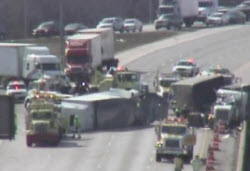Transportation Security and Incident Management Strategy Paper
Security and Emergency Management Summary
Table of Contents
- Executive Summary
- Introduction & Context
- Practices by Peer MPOs
- Issues and Options in GO TO 2040
-
Recommendations
- Identify Regional Role & Activities
- Develop Policies
- Integrate with Current CMAP Activities
- Consider when Evaluating System Performance
- Conclusion
- Appendices
 This action strategy paper provides an overview of how the Chicago Metropolitan Agency for Planning (CMAP) can incorporate security and emergency management into its ongoing planning activities, such as geographical data management and intelligent transportation system development, as well as preparation of the GO TO 2040 Plan (e.g., building and evaluating scenarios, designing and using indicators, and evaluating capital projects). Specifically, it offers CMAP guidance on framing its role in regional security planning, as well as weaving the topic into ongoing CMAP planning activities. Addressing security and emergency management issues can support the policies, investments and actions needed to implement CMAP's vision to promote and sustain an efficient urban economy as well as efficient travel throughout the region.
This action strategy paper provides an overview of how the Chicago Metropolitan Agency for Planning (CMAP) can incorporate security and emergency management into its ongoing planning activities, such as geographical data management and intelligent transportation system development, as well as preparation of the GO TO 2040 Plan (e.g., building and evaluating scenarios, designing and using indicators, and evaluating capital projects). Specifically, it offers CMAP guidance on framing its role in regional security planning, as well as weaving the topic into ongoing CMAP planning activities. Addressing security and emergency management issues can support the policies, investments and actions needed to implement CMAP's vision to promote and sustain an efficient urban economy as well as efficient travel throughout the region.
By exploring security and emergency management-related initiatives at peer MPOs, this paper shows how security-related issues can be successfully integrated into the regional comprehensive planning process. An important component of integration is linking security and emergency management to other action strategy topics (e.g., freight, climate change, public-private partnerships, public transportation, arterial and local road improvements, travel demand management, and addressing accessibility). CMAP could incorporate security and emergency management planning activities into its everyday transportation planning functions, as well as into its comprehensive long-range planning, including:
- Development of security-related policies;
- Consideration of security and emergency management in investment and funding decisions;
- Consideration of evacuation and multi-modal system redundancy (and performance measures) in regional travel modeling;
- Development of an inventory of special needs populations;
-
Coordination with other key MPO functions, such as:
- Regional public transportation support,
- Geographic Information Systems (GIS) data management and analysis,
- Intelligent Transportation Systems (ITS) development and support; and
- Development of partnerships across the region to address security and emergency management.
If you're interested in learning more about security and emergency management, please review the following strategy report, completed by the Volpe Transportation Center for CMAP. Comments and criticism are encouraged.
Photo is from a screenshot of real-time cameras of I-290 at Grand Avenue on March 29, 2010 from the Lake Michigan Interstate Gateway Alliance website.
|
Links Related Links |